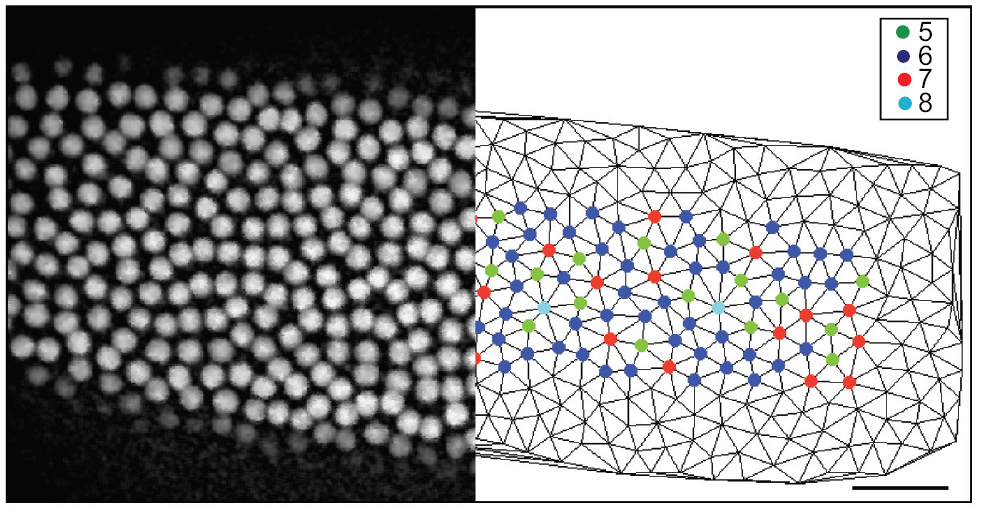|
|
Physics of tissue

|
| Digital fly: using image processing, we have reconstructed the dynamic neighborship relations in a two-dimensional slice through the Drosophila syncytium, which is a rapidly growing tissue without cell walls. The spatial arrangement of the nuclei is determined by cytoskeletal networks. The colour code shows the numbers of neighbors each nucleus has. |
Although much progress has been made recently in understanding the role of mechanics and forces for single cells, how these mechanisms work together in a tissue context is still a formidable challenge. It has long been appreciated that tissue development and maintenance are strongly shaped by mechanical processes, but recently studies of these effects have become more quantitative. To this end, one requires to combine image processing with quantitative models for tissue organization.
By quantitative analysis of tissue shape pinned to the substrate by inserted posts, we have found that it is determined by the interplay between active contractility and fibrous mechanics (Biophysical Journal 2008).
In order to better understand how cells collectively pull in a cell sheet adhering to a layer of elastic pillars, we have combined elasticity theory with concepts for the thermal cooling of material (Physical Review Letters 2011).
In collaboration with the Grosshans group, we have analyzed the dynamics of neighborship relations in the fast growing tissue of Drosophila embryos. Our results show that order in the nuclear array is perturbed by spindle elongation, but reestablished in a biphasic manner by different processes in the actin and microtubule networks (Integrative Biology 2011).
Publications:
- I. B. Bischofs, F. Klein, D. Lehnert, M. Bastmeyer, and U. S. Schwarz. Filamentous network mechanics and active contractility determine cell and tissue shape. Biophys. J., 95:3488-3496, 2008. (abstract, doi:10.1529/biophysj.108.134296, PDF, Supplemental Material)
- Carina M. Edwards and Ulrich S. Schwarz. Force localization in contracting cell layers. Phys. Rev. Lett., 107:128101, 2011. (abstract, doi:10.1103/PhysRevLett.107.128101, PDF, Supplemental material)
- T. Kanesaki, C.M. Edwards, U.S. Schwarz, and J. Grosshans. Dynamic ordering of nuclei in syncytial embryos: a quantitative analysis of the role of cytoskeletal networks. Integr. Biol., 3:1112-9, 2011. (abstract, DOI:10.1039/C1IB00059D, PDF, Supplemental material)
Last modified Wed Dec 21 16:03:38 CET 2011
by USS.
Back to home page Ulrich Schwarz.

